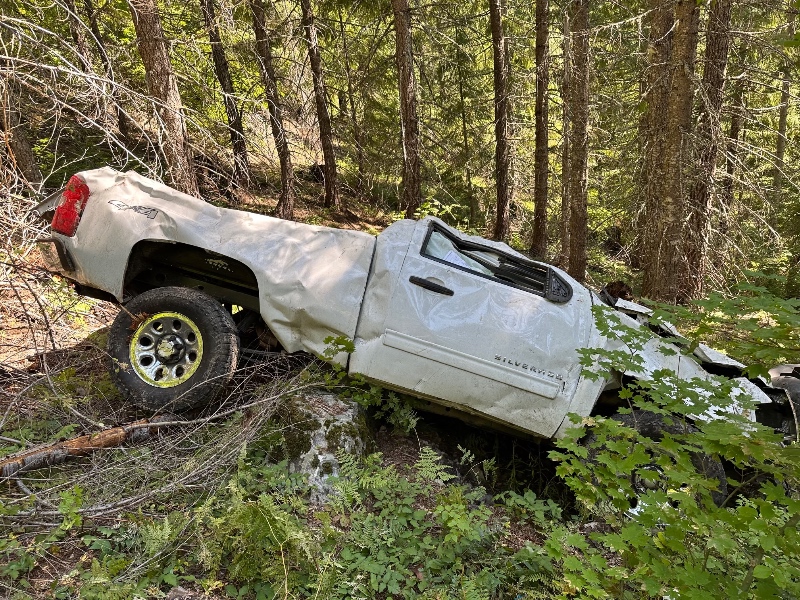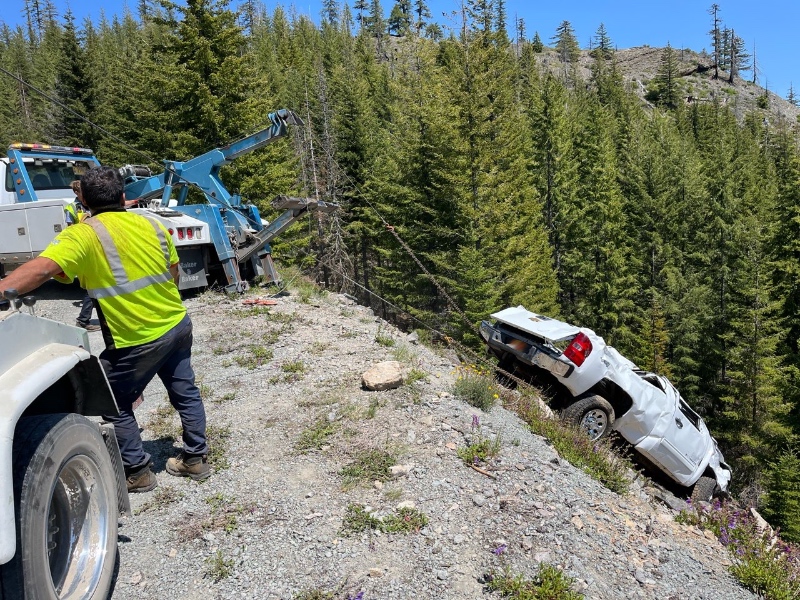The Job That Took Us to the Edge
We’ve handled some tough towing jobs before, but this Detroit off-road vehicle recovery operation pushed us to plan, climb, and winch like never before. Last fall, someone driving a truck deep in the Oregon backcountry lost control near Mt. Jefferson and tumbled 750 feet down a steep embankment. One of the fenders ended up pierced by a log. After that, the truck vanished. No one knew where it had landed. It wasn’t until the U.S. Forest Service stumbled upon it in the snow that the story picked back up. They let the owner know, and in early June, once the forest roads finally cleared, we headed out to bring it back.


What It Took to Find the Car and Plan the Recovery
The spot was deep, about 45 minutes of rugged driving past Detroit, Oregon, up US Forest Service Roads. We started with a scouting day. Kevin and Jon went out to get eyes on the situation and figure out how we could get the truck out. Jon hiked down and across the hillside just to reach the wreck. It was no quick walk, as just reaching the site chewed up a big part of the day. That’s when we knew this wasn’t going to be a simple winch-and-go, but a complex off-road accident vehicle recovery.
We prepped for serious conditions. High elevation, thick brush, logs everywhere, and no clear path to the truck. We packed our gear accordingly: two medium-duty trucks (units 203 and 207), climbing harnesses, chainsaws, and a whole lot of wire rope. We were ready for one of the most difficult Detroit off-road vehicle recovery situations we had seen in a while.
Getting It Done: Step by Step
On recovery day, our Detroit off-road vehicle recovery team—Tenny, Nick, Jon, and Oscar—was all in. Three of us went down to the truck while two stayed up top to manage the winches. Everyone used radios to keep communication tight. We cut through dense brush and logs to make a path, then set up the winch system with all the wire rope we brought. It took hours to thread the line 750 feet down the embankment.
With everything in place, we slowly began winching the vehicle up the hill. Inch by inch, foot by foot, we guided it up, clearing rocks and debris as we went. Chainsaws stayed busy and climbing harnesses kept the downhill crew safe. It took six solid hours of winching and four more of setup, breakdown, and travel. After ten hours on site, we got the truck up and hauled it off to the yard.
Tools Use for this Oregon Mountain Towing & Recovery
When you’re working a Detroit off-road vehicle recovery mission in extreme terrain like this, there’s no single piece of equipment that does it all. You need planning, teamwork, and gear that works hard:
- Climbing harnesses for navigating steep, unstable hillsides.
- Chainsaws for clearing fallen trees and brush.
- Long wire rope spools for extended winch-outs.
- Medium-duty trucks powerful enough to anchor and pull.
- Radios for coordination across hundreds of feet of elevation change.
It was a classic example of a vehicle winch-out our US Forest Service roads can demand: steep, remote, and full of surprises.

Baker & Baker: Detroit Off-Road Vehicle Recovery Done Right
This wasn’t just another Detroit off-road vehicle recovery. The truck had been missing for months. The terrain was unforgiving. But Detroit off-road vehicle recovery jobs like this one highlight exactly why we do what we do. Our extreme terrain tow service team took on this Mt. Jefferson tow truck recovery challenge, using every skill they’ve got, and brought that truck back from the forest floor.
Detroit, OR, mountain recovery towing often involves hidden hazards and long hikes. You can’t shortcut these kinds of Oregon remote recovery towing jobs. Remote recovery towing in Oregon is never just about hauling a vehicle, but about solving a puzzle, adapting on the fly, and keeping everyone safe while doing it.
Whether it’s backcountry vehicle recovery Mt. Jefferson, logging road vehicle recovery Oregon, remote location tow services Oregon-wide or Oregon service vehicle recovery, we’ve got the gear and the grit to handle it. That truck may be sitting in our yard now, but we’ll remember the mountain it came from for a long time.


